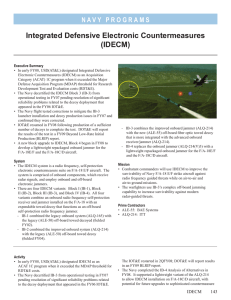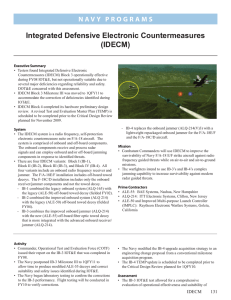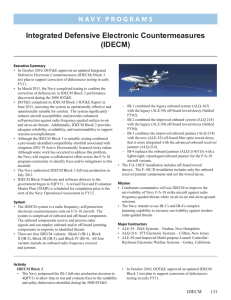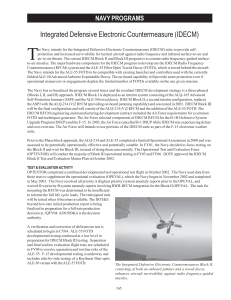Integrated Defensive Electronic Countermeasures (IDECM)
advertisement
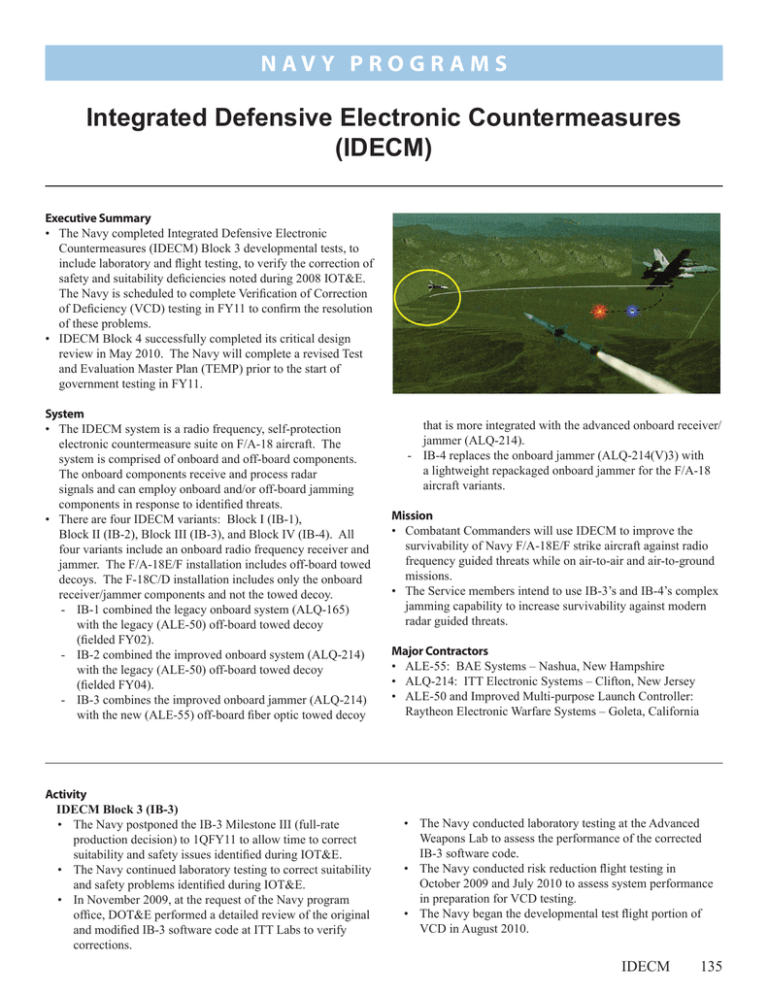
N a v y P ROGRAMS Integrated Defensive Electronic Countermeasures (IDECM) Executive Summary • The Navy completed Integrated Defensive Electronic Countermeasures (IDECM) Block 3 developmental tests, to include laboratory and flight testing, to verify the correction of safety and suitability deficiencies noted during 2008 IOT&E. The Navy is scheduled to complete Verification of Correction of Deficiency (VCD) testing in FY11 to confirm the resolution of these problems. • IDECM Block 4 successfully completed its critical design review in May 2010. The Navy will complete a revised Test and Evaluation Master Plan (TEMP) prior to the start of government testing in FY11. System • The IDECM system is a radio frequency, self-protection electronic countermeasure suite on F/A-18 aircraft. The system is comprised of onboard and off-board components. The onboard components receive and process radar signals and can employ onboard and/or off-board jamming components in response to identified threats. • There are four IDECM variants: Block I (IB-1), Block II (IB‑2), Block III (IB-3), and Block IV (IB-4). All four variants include an onboard radio frequency receiver and jammer. The F/A-18E/F installation includes off-board towed decoys. The F-18C/D installation includes only the onboard receiver/jammer components and not the towed decoy. - IB-1 combined the legacy onboard system (ALQ-165) with the legacy (ALE-50) off-board towed decoy (fielded FY02). - IB-2 combined the improved onboard system (ALQ‑214) with the legacy (ALE-50) off-board towed decoy (fielded FY04). - IB-3 combines the improved onboard jammer (ALQ-214) with the new (ALE-55) off-board fiber optic towed decoy Activity IDECM Block 3 (IB-3) • The Navy postponed the IB-3 Milestone III (full-rate production decision) to 1QFY11 to allow time to correct suitability and safety issues identified during IOT&E. • The Navy continued laboratory testing to correct suitability and safety problems identified during IOT&E. • In November 2009, at the request of the Navy program office, DOT&E performed a detailed review of the original and modified IB-3 software code at ITT Labs to verify corrections. that is more integrated with the advanced onboard receiver/ jammer (ALQ-214). - IB-4 replaces the onboard jammer (ALQ-214(V)3) with a lightweight repackaged onboard jammer for the F/A-18 aircraft variants. Mission • Combatant Commanders will use IDECM to improve the survivability of Navy F/A-18E/F strike aircraft against radio frequency guided threats while on air-to-air and air-to-ground missions. • The Service members intend to use IB-3’s and IB-4’s complex jamming capability to increase survivability against modern radar guided threats. Major Contractors • ALE-55: BAE Systems – Nashua, New Hampshire • ALQ-214: ITT Electronic Systems – Clifton, New Jersey • ALE-50 and Improved Multi-purpose Launch Controller: Raytheon Electronic Warfare Systems – Goleta, California • The Navy conducted laboratory testing at the Advanced Weapons Lab to assess the performance of the corrected IB-3 software code. • The Navy conducted risk reduction flight testing in October 2009 and July 2010 to assess system performance in preparation for VCD testing. • The Navy began the developmental test flight portion of VCD in August 2010. IDECM 135 N a v y P ROGRAMS • The Navy conducted testing in accordance with the DOT&E approved TEMP and Test Plan. IDECM Block 4 (IB-4) • The Navy completed the IB-4 ALQ-214 preliminary design review in November 2009 and the overall critical design review in May 2010. Initial hardware deliveries to the government will begin 2QFY11. • In accordance with the updated acquisition strategy, the Navy conducted the first two (of six total) in-process reviews in March and July 2010, respectively. • The IB-4 TEMP update is scheduled to be completed prior to the start of government testing in FY11. Assessment IDECM Block 3 (IB-3) • A detailed review of the software code and laboratory testing of the original and revised software increased confidence that the cause of uncommanded decoy deployments has been identified and corrected. This testing also suggests the built-in test (BIT) false alarm rate has improved. VCD flight testing should further confirm this assessment. • DOT&E is awaiting the results of the VCD to complete the Beyond Low-rate Initial Production Operational Test Report in time to support Milestone III. Recommendations • Status of Previous Recommendations. The eight FY09 recommendations remain outstanding and require continued attention. The three recommendations related to resolving suitability issues are dependent upon post-VCD analysis and reporting. Status of those recommendations will be provided in the FY11 report. 136 IDECM • FY10 Recommendations. There are no new FY10 recommendations. The following are outstanding FY09 recommendations that remain to be resolved. IDECM System 1. The Navy should complete adequate flight testing to confirm that decoy safety, maintenance, and reliability deficiencies have been resolved, and that the BIT false alarm rate has been reduced. 2. The Navy should develop hardware and/or software changes to provide the pilot with correct indications of whether a decoy was successfully severed. 3. The Navy should continue to improve maintenance procedures and training to reduce the incidence of incorrectly installed magazines and contaminated electrical contacts. 4. The Navy should investigate the susceptibility and effects of IDECM on threat missile fuses. 5. The Navy should continue to fund and develop new countermeasure techniques to improve IDECM effectiveness and keep pace with threat advancements. 6. The Navy should explore new tactics, techniques, and procedures to provide optimal aircraft and aircrew survivability when IDECM is employed. Electronic Warfare Warfighting Improvements 6. In coordination with DoD and other electronic warfare programs, the Navy should continue to develop an enterprise approach to updating and upgrading laboratory and open-air range modeling and simulation capabilities. 7. In coordination with the Defense Intelligence Agency, the Navy should update the threat lethal radii and/or the evaluation processes that are used to determine whether simulated shots are hits or misses.
